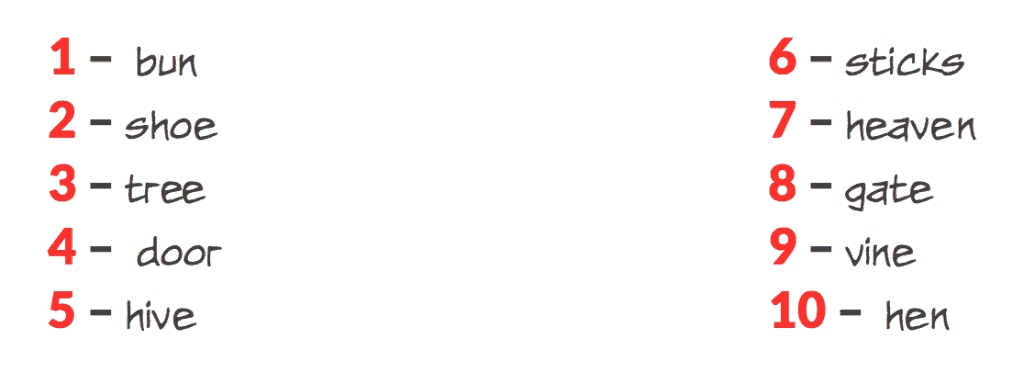Stop right there! This just may very well be the most important technique you learn to aid youin your Korean language learning journey.
It’s not common for you to see an explanation of a memorization technique in a language-learning program, but going forward, this technique can be very useful and so it is appropriate to learn here.
Starting to learn a new language is the hardest part — the sounds are new, the words have little meaning to you in the beginning and it’s hard to grasp new concepts and associate new vocabulary words into your knowledge base.
This forces many language learners to rely on straight memorization, which can halt progress, incite boredom or destroy motivation.
Oh my!
On the other hand, using a mnemonic device system can allow to associate new words devoid of meaning to us with with words we already know.
Here’s a simple and easy-to-use system that has worked for many 90 Day Korean learners to rapidly increase their ability to memorize lists of words and recall them in any order!
Peg System
Take a look at the following list of ten words. Each word rhymes with the number it is associated with.
If we memorize this list, which is easy to do since it rhymes, we can associate new words we learn with the corresponding number really easily. All we need to do is make a picture in our head.
Go ahead and memorize the list of ten words now! Do it as a rhyme: One, bun. Two, shoe. Three, tree. And so on.
Ready to move on?
The beauty of this list of words is that they rhyme with the number so they are easy to recall and they are words that are easy to picture in our heads.
Imagine we were memorizing the following list of five random English words:
1. Telephone
2. Gum
3. Ax
4. Hole
5. Head
We could associate each with the rhyme we just memorized.
The best way to do this is to make a strange and memorable image in your head. If you’re a visual learner anyway, this will be easy!
Making Pictures in Your Head
1. a bun with a telephone in it instead of a hot dog. Yummy!
2. a shoe with a big pink piece of bubble gum stuck to the bottom.
3. an ax chopping down a big tree.
4. a door someone kicked that has a large hole in it.
5. a person’s head that got stuck in a bee’s hive! Ouch!
Take a moment and make these pictures in your head now. Try it!
These are very memorable images that we can’t easily forget, and all we did is associate the new words to the word pairing list we memorized before.
Did you make the pictures in your head? Well then it should be easy to recall the new list of five words now. Go ahead and try!
What was number 1? How about 2, 3, 4 and 5?
Ready to check? Let’s get to it.
Use the rhyme to assist you.
Check Your Answers
1. One, bun. A bun with a phone in it. Telephone!
2. Two, shoe. A shoe with a piece of gum on it. Gum!
3. Three, tree. An ax chopping down a tree. Ax!
4. Four, door. A door with a hole in it. Hole!
5. Five, hive. A head inside a beehive. Head!
And that’s not all. You could now recall these in any order, not just in the order they were presented.
For example, if asked what number 4 on that list was, you could easily remember it.
Four, door.Hole!
The associations stick and allow for easily recollection.
By memorizing the first rhyming list of 10 words, you create your own “peg” system for memorizing future vocabulary words. The words and numbers are the “pegs” that you can associate new words to.
Remember, this is just one way to memorize new words in the beginning, when appropriate. You won’t always rely on this. After using the new words you’re learning a few times in sentences and conversations, it will be second nature to use them and you won’t need this technique.
When associating new Korean words with the list, you have to get creative with the system since you are using a new language and words that have no meaning to you in the beginning.
But there are a few techniques you can use to do so effectively, and the best way is to find words in English that sound similar to the Korean words or words that you could easily link up in your mind.
Let’s take a look at an example of how we could use this to learn the numbers 1-10 in Korean.
How to Memorize Korean Numbers Quickly and Easily
Recall, the peg system would just act as a reminder of the actual words.
In Korean, you may know that the numbers 1-10 are the building blocks for learning the rest of the numbers. It can be hard to associate them at first.
Here is the list:
| English | 한국어 (Korean) |
|---|---|
| One | 일 |
| Two | 이 |
| Three | 삼 |
| Four | 사 |
| Five | 오 |
| Six | 육 |
| Seven | 칠 |
| Eight | 팔 |
| Nine | 구 |
| Ten | 십 |
To do this, you may use the following system for example, making these absorb pictures in your mind to help link up the peg system word and an English word that sounds similar to the Korean number word.
1. Eel One, bun.
A picture of a giant electric eel (일)on a hot dog bun.
2.“E” Two, shoe.
A basketball sneaker with a gigantic letter “E” (이) on the side.
3. Same Three, tree.
The silhouette of three identical (same) (삼) tall trees on a hilltop
4. Saw Four, door.
A saw (사) cutting through a door. Think of the horror movie “Saw.”
5.“O”Five, hive.
Honey Nut Cheerios. Os (오) covered in honey from a beehive.
6. Yuk! Six, sticks.
Using sticks to poke at something “yucky” (육) in the forest.
7. Chill Seven, heaven.
Arriving in heaven. A soft wind blows, giving you the chills (칠).
8. Pal Eight, gate.
A good pal(팔) opening the gate for you and patting you on the back as you enter.
9. Goo Nine, vine.
Tarzan swinging on a vine that is covered in goo (구). He falls down into the river.
10. Ship Ten, hen.
A big ship (십) transporting only hens. Imagine the chaos!
Be careful not to use this as pronunciation guide, but rather a compass pointing you in the right direction toward the Korean numbers.
You still need to memorize the number words, but linking them up with the corresponding number can be difficult in the beginning. In other words, you may remember the names, but it’s hard to quickly recall which number is which.
Many people may just memorize the list of numbers 1-10 in order and then when using them in real-life scenarios, need to to count on their hands or think for a while before responding or taking action. You need the preceding number as a cue to recall the next. This is especially troublesome in situations that require a quick response or action, like when paying for goods at the counter in a big lineup, for example.
Using a peg system has many advantages, including being able to recall the numbers in any order instantly. However, feel free to use any method to memorize the words — whatever works best for you! Repetition works just as well if you get to the same result in the end!
You could use this to memorize lists of daily vocabulary or themed vocabulary like the ones in the 90 Day Korean Inner Circle.
Do you have any ideas about how you could use this system to help make memorizing Korean words easier?
Image Credit: Allan Afajo
 Learn to read Korean and be having simple conversations, taking taxis and ordering in Korean within a week with our FREE Hangeul Hacks series: http://www.90DayKorean.com/learn
Learn to read Korean and be having simple conversations, taking taxis and ordering in Korean within a week with our FREE Hangeul Hacks series: http://www.90DayKorean.com/learn



